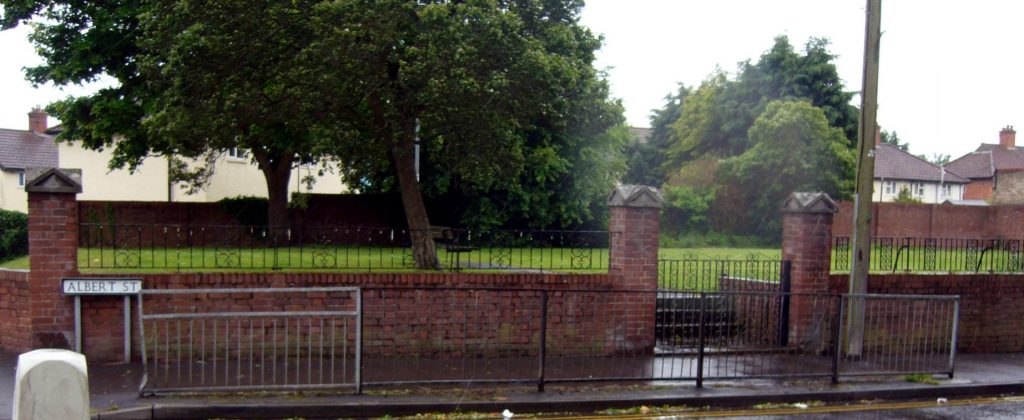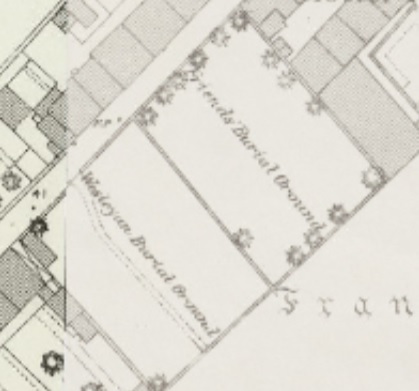This page explores the history of the Wesleyan Methodist Burial Ground in Albert Street, Bridgwater. The first Methodist chapel was established in Bridgwater in 1753, one in Eastover by 1800 and the Wesleyan Chapel, the congregation who buried in Albert Street, was built in King Street in 1816 (VCH).


Primarily gathered from materials preserved at the Somerset Heritage Centre D/N/bmc/2/3/10, other sources being mentioned in the text.
On 23 and 24 November 1835 a garden adjoining the west side of the Society of Friends’ burial ground was purchased by the Wesleyan Methodist Congregation, led in this transaction by a William Loton, a stonemason (Somerset Heritage Centre D/N/bmc/1/1/2). The street was then called Roper’s Lane. Oddly, burials appear to have been made in the ground since 1830, so presumably this transaction either finalised a more long-term understanding, or else remains were transferred here from a previous burial ground. To add to the confusion, in the 1870s, a questionnaire returned to the Burial Acts Office seemed to think that the ground had opened in 1832. The earliest date here is possibly the most likely.
The burial ground was about 529 square yards. Most graves were dug directly into the ground, where there were about 9 brick vaults for family burials (at least in the 1870s). Each grave was dug to a depth of about 10 to 12 feet deep.
The rules for the burial ground were set out after a meeting of the superintendent preachers and the chapel stewards on 15 July 1833. Present were the Reverend J Bessey, Solomon Rich, William Loton, John Davis, Richard Preece and Henry Evans. From this we learn that an arrangement had previously been put in place by a John Snook to grade the pricing of the burials depending on the rows. This was rescinded, and a uniform fee of 5 shillings across the burial ground was put in place. The management of the burial ground stipulated that there should be only one burial per plot, although additional burials were permitted in the brick family vaults, or in the case of children of the same parents dying within six months of each other. No memorial over five feet tall was permitted (in the event, only one standing tombstone seems to have ever been erected), and each grave was to be mounded with gravel once a year. A plan of the burial ground accompanied this document, showing a total of sixteen burials had taken place there so far. A few additional rules were added over time, scribbled onto the last document in pencil. No flat stones were to be raised over ‘common’ graves – presumably meaning they were only reserved for brick vaults.
In January 1857 the rules were tweaked by another committee consisting of Reverend William Culcheth, John Coombs, Robert Kitch, John King, Charles Tolman and Thomas Hutchings. The doubling of burials within a plot was now permitted for siblings under the age of seven, no matter how far apart in time they died, and children could be buried with their parents if they died within the space of six months. A new rule was added that only members of the Wesleyan Methodist Society, or regular attendants of the congregation or their children could be buried in the ground. Another plan of the cemetery was drawn up at the same time.
An undated scrap of paper lists the full range of fees for the burial ground, which seems to be a revision of the 5 shilling flat rate. The cost of a new grave, as well as reopening a grave, would incur a fee of 4 shillings and 6 pence for the grave digger, and 3 shillings for the minister’s fee. A brick vault with stone would be charged at 6 shillings for the digger (although only 2 shillings and 6 pence for reopening) and 5 shillings for the minister. A pencil note at the bottom of this list records ‘Still Born Child’, which incurred a fee of one shilling to the grave digger, and no ministerial fee.
Unfortunately, complete records for the burial ground do not survive, and only scraps of information relating to the period 1831 to 1879 are preserved, despite clear evidence for burials after this date, even as late as 1912 and possibly beyond. Up to 1879 there are 142 known burials, when roughly half the land was used up. There is another gap in the records between 1834 and 1840. In total we may assume up to about 300 burials in total.
Some controversy seems to have arisen in 1858, probably a result of the previous year’s rule excluding non-Wesleyans from the site, as a Mr John Edwards, a coach builder of West Street, took out an advertisement in the Bridgwater Mercury (31 March 1858) complaining that the trustees of the Wesleyan burial ground had refused him the right to bury in a vault he had had built at his own expense. As such he was putting the vault up for sale, having removed the bodies of those previously buried there to the Wembdon Road Cemetery.
Another unsavoury incident occurred in the burial ground a few years later. In the Sherborne Mercury of Tuesday 12 March 1867, a letter was reprinted from the Bridgwater Mercury, complained that a burial the previous Tuesday (possibly Walter Long buried that year) of
‘the body of young man of respectability was consigned to its last resting place in the Wesleyan burial ground in Albert Street, and, almost incredible as it may seem, the grave was allowed to remain open, and the coffin exposed until the following Thursday morning! The fact that the grave had not been filled up, and, indeed, not a shovel full of earth had been thrown into the pit to cover the coffin, was known among the inhabitants of the immediate locality early on the following (Wednesday) morning, and in the afternoon or evening of that day the affair had been so much talked about that the authorities were communicated with. Sergeant Cheriton proceeded to the spot, and found the state of things to be as described, and the father of deceased, a resident of Wembdon, was informed of it. The grave was not, however, entirely filled up until Thursday morning, and we have heard it stated that the only reason assigned for the delay was that it was too wet for out door work!
Due to resistance (although not apparently always observed in practice) to multiple burials in the same plot, the ground was ultimately filled up with burials, hence its eventual disuse. Like the adjoining Society of Friends’ burial ground, the burial ground was eventually transferred to Bridgwater Borough Council, with a view to using part of the site to widen Albert Street. This was part of a wider process of slum clearance around the Albert Street and West Street areas. Although the process began in 1934, it was initially rejected by relatives of the Wesleyans buried there. After the Friends’ ground had been transferred, the issue was reopened in 1937, although not completed until 14 April 1941. This was made on the conditions that the ground would be used as a public green space, but not as a children’s playground, that the land would never be built on, and that the burials would not be disturbed, aside from those earmarked for road-widening, who would be reburied in the ground.
The Town Council expended some £2,250 in laying out the Albert Street Burial Ground (presumably both Friends and Wesleyan) in 1960, which is presumably when the current walls, gate and railings were installed (Taunton Courier and Western Advertiser, 5 March 1960).
The surviving memorials seem to consist of one tombstone and the five large recumbent slabs.
For a known list of all the individuals buried here, visit the Members’ section on the website of the Friends of the Wembdon Road Cemetery.
Miles Kerr-Peterson, September 2020
